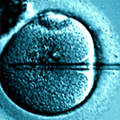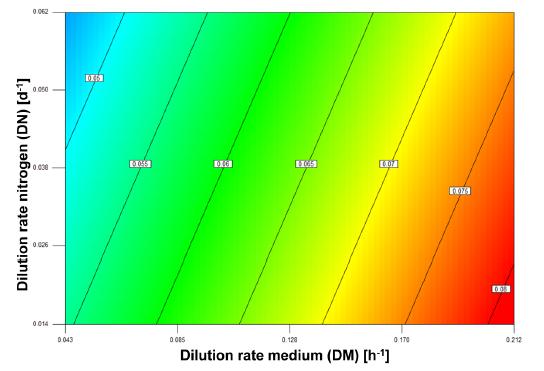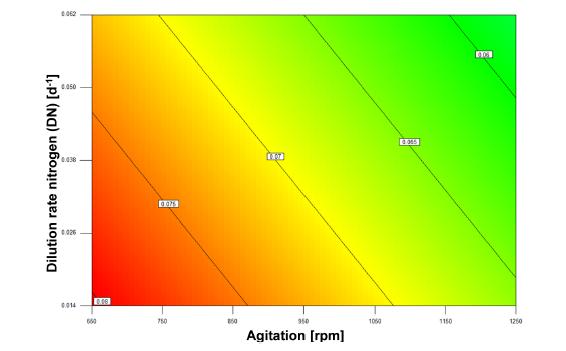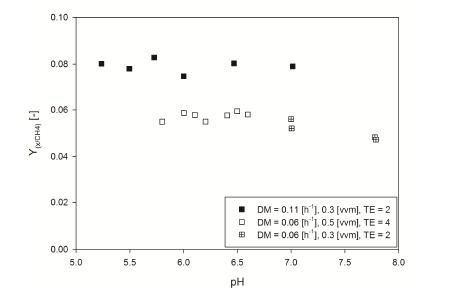New generation biofuels are a suitable approach to produce energy carriers in an almost CO2 neutral way. A promising reaction is the conversion of carbon dioxide (CO2) and molecular hydrogen (H2) to methane (CH4) and water (H2O). In this contribution, this so-called Sabatier reaction was performed biologically by using hydrogenotrophic and autotrophic methanogenic microorganisms from the archaea life domain. For the development of a biological methane production (BMP) process, one key parameter is the ratio of biomass production rate (rx) to methane evolution rate (MER) reflected in the growth to product yield (Y(x/CH4)) because it represents both a physiological and a scalable entity for the bioprocesses development as it quantify the selectivity of reaction with respect to the carbon. Y(x/CH4) needs also to be held constant in order to establish an adaptable media composition for developing a scalable feeding strategy. Identification of parameters and quantification of their impact on Y(x/CH4) is a necessary prerequisite for obtaining a growth kinetic model and developing advanced process control strategies especially for dynamic operation modes. In this work, process conditions and parameters impacting Y(x/CH4) were investigated by using a combination of multivariate and univariate chemostat cultures, as well as dynamic experiments. The proposed combination of methods is a novel modular approach for the development of BMP processes. It allowed determining the effects of multiple process factors on physiology and methane productivity of Methanothermobacter marburgensis. In fact, quantitative analysis of basal medium, sulphide and ammonium dilution rates, as well as the ammonium concentration revealed that all these variables vary rx without affecting MER. Hence Y(x/CH4) can be used to identify limiting or inhibiting conditions during media development tasks as well as for tuning the carbon flux of the bioprocess in an industrial application by reducing Y(x/CH4) to improve the carbon balance of the reaction.
1.
Introduction
Fluid-particle interaction model arises in many practical applications, and is of primary importance in the sedimentation analysis of disperse suspensions of particles in fluids. This model is one of the commonly used models nowadays in biotechnology, medicine, mineral processing and chemical engineering [27]-[25]. Usually, the fluid flow is governed by the Navier-Stokes equations for a compressible fluid while the evolution of the particle densities is given by the Smoluchowski equation [4], the system has the form:
where $ \rho,u,\eta $, $ P(\rho) = a\rho^\gamma $, $ \Phi(x) $ denote the fluid density, velocity, the density of particles in the mixture, pressure, and the external potential respectively, $ a>0,\gamma>1 $. $ \mu>0 $ is the viscosity coefficient, and $ 3\lambda+2\mu\geq 0 $ are non-negative constants satisfied the physical requirements.
There are many kinds of literatures on the study of the existence and behavior of solutions to Navier-Stokes equations (See [1]-[17]). Taking system (1) as an example, Carrillo $ et\ al $ [4] discussed the the global existence and asymptotic behavior of the weak solutions providing a rigorous mathematical theory based on the principle of balance laws, following the framework of Lions [18] and Feireisl $ et\ al $ [11,12]. Motivated by the stability arguments in [5], the authors also investigated the numerical analysis in [6]. Ballew and Trivisa [1] constructed suitable weak solutions and low stratification singular limit for a fluid particle interaction model. In addition, Mellet and Vasseur [20] proved the global existence of weak solutions of equations by using the entropy method on the asymptotic regime corresponding to a strong drag force and strong brownian motion. Zhang $ et\ al $ [31] establish the existence and uniqueness of classical solution to the system (1).
Despite the important progress, there are few results of non-Newtonian fluid-particle interaction model. As we know, the Navier Stokes equations are generally accepted as a right governing equations for the compressible or incompressible motion of viscous fluids, which is usually described as
where $ \Gamma $ denotes the viscous stress tensor, which depends on $ E_{ij}(\nabla u) $, and
is the rate of strain. If the relation between the stress and rate of strain is linear, namely, $ \Gamma = \mu E_{ij}(\nabla u) $, where $ \mu $ is the viscosity coefficient, then the fluid is called Newtonian. If the relation is not linear, the fluid is called non-Newtonian. The simplest model of the stress-strain relation for such fluids given by the power laws, which states that
for $ 0<q<1 $ (see[3]). In [16], Ladyzhenskaya proposed a special form for $ \Gamma $ on the incompressible model:
For $ \mu_0 = 0 $, if $ p<2 $ it is a pseudo-plastic fluid. In the view of physics, the model captures the shear thinning fluid for the case of $ 1<p<2 $ (see[19]).
Non-Newtonian fluid flows are frequently encountered in many physical and industrial processes [8,9], such as porous flows of oils and gases [7], biological fluid flows of blood [30], saliva and mucus, penetration grouting of cement mortar and mixing of massive particles and fluids in drug production [13]. The possible appearance of the vacuum is one of the major difficulties when trying to prove the existence and strong regularity results. On the other hand, the constitutive behavior of non-Newtonian fluid flow is usually more complex and highly non-linear, which may bring more difficulties to study such flows.
In recent years, there has been many research in the field of non-Newtonian flows, both theoretically and experimentally (see [14]-[26]). For example, in [14], Guo and Zhu studied the partial regularity of the generalized solutions to an incompressible monopolar non-Newtonian fluids. In [32], the trajectory attractor and global attractor for an autonomous non-Newtonian fluid in dimension two was studied. The existence and uniqueness of solutions for non-Newtonian fluids were established in [29] by applying Ladyzhenskaya's viscous stress tensor model.
In this paper, followed by Ladyzhenskaya's model of non-Newtonian fluid, we consider the following system
with the initial and boundary conditions
and the no-flux condition for the density of particles
where $ \rho,u,\eta $, $ P(\rho) = a\rho^\gamma $, $ \Phi(x) $ denote the fluid density, velocity, the density of particles in the mixture, pressure, and the external potential respectively, $ a>0,\gamma>1,\frac{4}{3}<p,q<2 $. $ \lambda>0 $ is the viscosity coefficient, $ \Omega $ is a one-dimensional bounded interval, for simplicity we only consider $ \Omega = (0,1) $, $ \Omega_T = \Omega\times[0,T] $.
The system describes a compressible shear thinning fluid-particle interaction system for the evolution of particles dispersed in a viscous non-Newtonian fluid and the particle is driven by non-Newtonian gravitational potential. To our knowledge, there still no existence results for (2)-(4) when $ 1<p,q<2 $. The aim of this paper is to study the existence and uniqueness of strong solutions to this system. Throughout the paper we assume that $ a = \lambda = 1 $ for simplicity. In the following sections, we will use simplified notations for standard Sobolev spaces and Bochner spaces, such as $ L^p = L^p(\Omega), H_0^1 = H_0^1(\Omega), C([0,T];H^1) = C([0,T];H^1(\Omega)) $.
We state the definition of strong solution as follows:
Definition 1.1. The $ (\rho,u,\Psi,\eta) $ is called a strong solution to the initial boundary value problem(2)-(4), if the following conditions are satisfied:
(ⅰ)
(ⅱ) For all $ \phi \in L^\infty(0,T_*;H^1(\Omega)) $, $ \phi_t \in L^\infty(0,T_*;L^2(\Omega)) $, for a.e. $ t \in (0,T) $, we have
(ⅲ) For all $ \varphi \in L^\infty(0,T_*;W_0^{1,p}(\Omega)\cap H^2(\Omega)) $, $ \varphi_t \in L^2(0,T_*;H_0^1(\Omega)) $, for a.e. $ t \in (0,T) $, we have
(ⅳ) For all $ \psi \in L^\infty(0,T_*;H^2(\Omega)) $, $ \psi_t \in L^\infty(0,T_*; H^1(\Omega)) $, for a.e. $ t\in (0,T) $, we have
(ⅴ) For all $ \vartheta \in L^\infty(0,T_*;H^2(\Omega)) $, $ \vartheta_t \in L^\infty(0,T_*;L^2(\Omega)) $, for a.e. $ t\in (0,T) $, we have
The main result of this paper is stated in the following theorem.
1.1. Main theorem
Theorem 1.2. Let $ \Phi\in C^2(\Omega) $, $ \frac{4}{3}<p,q<2 $ and assume that the initial data $ (\rho_0,u_0,\eta_0) $ satisfy the following conditions
and the compatibility condition
for some $ g\in L^2(\Omega) $. Then there exist a $ T_*\in(0,+\infty) $ and a unique strong solution $ (\rho,u,\Psi,\eta) $ to (2)-(4) such that
Remark 1. By using exactly the similar argument, we can prove the result also hold for the case $ 1 <p,q\leq\frac{4}{3} $. We omit the details here.
2.
A priori estimates for smooth solutions
In this section, we will prove the local existence of strong solutions. From the continuity equation $ (2)_1 $, we can deduce the conservation of mass
Because equation $ (2)_2 $ possesses always with singularity, we overcome this difficulty by introduce a regularized process, then by taking the limiting process back to the original problem. Namely, we consider the following system
with the initial and boundary conditions.
and $ u_0\in H_0^1(\Omega)\cap H^2(\Omega) $ is the smooth solution of the boundary value problem
Provided that $ (\rho,u,\eta) $ is a smooth solution of (10)-(15) and $ \rho_0\geq \delta $, where $ 0<\delta\ll 1 $ is a positive number. We denote by $ M_0 = 1+ \mu_0+ \mu^{-1}_0+|\rho_0|_{H^1}+|g|_{L^2} $.
We first get the estimate of $ |u_{0xx}|_{L^2} $. From (16), we have
Then
Applying Young's inequality, we have
thus
where $ C $ is a positive constant, depending only on $ M_0 $.
Next, we introduce an auxiliary function
We will derive some useful estimate to each term of $ Z(t) $ in terms of some integrals of $ Z(t) $, then apply arguments of Gronwall's inequality to prove $ Z(t) $ is locally bounded.
2.1. Preliminaries
In order to prove the main Theorem, we first give some useful lemmas for later use.
Lemma 2.1. Let $ u_{0}\in H^{1}_{0}(\Omega)\cap H^{2}(\Omega) $, $ \rho_0\in H^{1}(\Omega) $, $ \eta_0\in H^{2}(\Omega) $, $ \Phi\in C^2(\Omega) $, $ g\in L^2(\Omega) $, $ u_0^\varepsilon $ is a solution of the boundary value problem
Then there are a subsequence $ \{u^{\varepsilon_j}_0\} $, $ j = 1,2,3,..., $ of $ \{u^{\varepsilon }_0\} $ and $ u_{0}\in H^{1}_{0}(\Omega)\cap H^{2}(\Omega) $ such that as $ \varepsilon_j\rightarrow 0 $,
Proof. According to (18), we have
Taking it by the $ L^2 $ norm, we have
then
Therefore, by the above inequality, as $ \varepsilon_j\rightarrow 0 $,
Thus, we can obtain $ \{u^{\varepsilon_j}_{0x}\} $ is a Cauchy subsequence of $ C^{\frac{3}{2}}(\Omega) $, for all $ \alpha_1>0 $, we find $ N $, as $ i, j > N $, and
Now, we prove that $ \{u^{\varepsilon}_{0xx}\} $ has a Cauchy sequence in $ L_2 $ norm.
Let
For all $ \alpha>0 $, there exists $ N $, as $ i, j > N $, we can deduce that
With the assumption, we can obtain
where $ C $ is a positive constant, depending only on $ |\rho_0|_{H^{1}(\Omega)} $, $ |g|_{L^{2}(\Omega)} $ and $ |\eta_0|_{H^{2}(\Omega)} $. Using the following inequality,
where $ 0<\theta<1 $.
By the simple calculation, we can get
where $ C $ depending only on $ p $, then
Substituting this into (18), we have
then there is a subsequence $ \{u^{\varepsilon_j}_{0xx}\} $ and $ \{u^{\varepsilon}_{0xx}\} $, such that
By the uniqueness of the weak convergence, we have
Since $ (P(\rho_0)+\eta)_x+\eta_0 \Phi_x-\rho_0^{1\over 2}(g+\Phi_x) $ are independent of $ \varepsilon $, the same that we obtain, as $ \varepsilon_j\rightarrow 0 $,
This completes the proof of Lemma 2.1.
Lemma 2.2.
where $ C $ is a positive constant, depending only on $ M_0 $.
Proof. We estimates for $ u $ and $ \eta $ for later use. It follows from (11) that
We note that
Taking it by the $ L^2 $ norm and using Young's inequality, we have
On the other hand, by $ (12) $, we have
Taking it by $ L^2 $-norm, using Young's inequality, which gives
This implies that
By (13), taking it by the $ L^2 $ norm, we have
Multiplying (10) by $ \rho $, integrating over $ \Omega $, we deduce that
Integrating it by parts, using Sobolev inequality, we obtain
Differentiating $ (10) $ with respect to $ x $, and multiplying it by $ \rho_x $, integrating over $ \Omega $, and using Sobolev inequality, we have
From (26) and (27) and the Gronwall's inequality, then lemma 2.2 holds.
Lemma 2.3.
where $ C $ is a positive constant, depending only on $ M_0 $.
Proof. Multiplying $ (13) $ by $ \eta $, integrating the resulting equation over $ \Omega_T $, using the boundary conditions (4) and Young's inequality, we have
Multiplying $ (13) $ by $ \eta_t $, integrating (by parts) over $ \Omega_T $, using the boundary conditions (4) and Young's inequality, we have
Differentiating $ (13) $ with respect to $ t $, multiplying the resulting equation by $ \eta_t $, integrating (by parts) over $ \Omega_T $, we get
Combining (29)-(31), we obtain the desired estimate of Lemma 2.3.
Lemma 2.4.
where $ C $ is a positive constant, depending only on $ M_0 $.
Proof. Using (10), we rewritten the (11) as
Multiplying (33) by $ u_t $, integrating (by parts) over $ \Omega_T $, we have
We deal with each term as follows:
By virtue of $ (10) $, we have
Substituting the above into (34), using Sobolev inequality and Young's inequality, we have
To estimate (36), combining (35) we have the following estimates
In exactly the same way, we also have
which, together with (36) and (37), implies (32) holds.
Lemma 2.5.
where $ C $ is a positive constant, depending only on $ M_0 $.
Proof. Differentiating equation $ (11) $ with respect to $ t $, multiplying the result equation by $ u_t $, and integrating it over $ \Omega $, we have
Note that
Let
from (24), it follows that
Combining (35), (40) can be rewritten into
Using Sobolev inequality, Young's inequality, $ (11) $, (24) and (25), we obtain
In order to estimate $ I_{11} $, we need to deal with the estimate of $ |\Psi_{xt}|_{L^2} $. Differentiating (12) with respect to $ t $, multiplying it by $ \Psi_t $ and integrating over $ \Omega $, we have
and
Let
then
Then (43) can be rewritten into
Using Young's inequality, combining the above estimates we deduce that
Substituting $ I_j(j = 1,2,\ldots,11) $ into (42), and integrating over $ (\tau,t)\subset (0,T) $ on the time variable, we have
To obtain the estimate of $ |\sqrt{\rho}u_t(t)|_{L^2}^2 $, we need to estimate $ \lim\limits_{\tau\rightarrow 0}|\sqrt{\rho}u_t(\tau)|_{L^2}^2 $. Multiplying (33) by $ u_t $ and integrating over $ \Omega $, we get
According to the smoothness of $ (\rho,u,\eta) $, we have
Then, taking a limit on $ \tau $ in (45), as $ \tau\rightarrow 0 $, we can easily obtain
This complete the proof of Lemma 2.5.
With the help of Lemma 2.2 to Lemma 2.5, and the definition of $ Z(t) $, we conclude that
where $ C,\tilde{C} $ are positive constants, depending only on $ M_0 $. This means that there exist a time $ T_1>0 $ and a constant $ C $, such that
where $ C $ is a positive constant, depending only on $ M_0 $.
3.
Proof of the main theorem
In this section, the existence of strong solutions can be established by a standard argument. We construct the approximate solutions by using the iterative scheme, derive uniform bounds and thus obtain solutions of the original problem by passing to the limit. Our proof will be based on the usual iteration argument and some ideas developed in [10]. Precisely, we first define $ u^0 = 0 $ and assuming that $ u^{k-1} $ was defined for $ k\geq 1 $, let $ \rho^k,u^k,\eta^k $ be the unique smooth solution to the following system
with the initial and boundary conditions
where
With the process, the nonlinear coupled system has been deduced into a sequence of decoupled problems and each problem admits a smooth solution. And the following estimates hold
where $ C $ is a generic constant depending only on $ M_0 $, but independent of $ k $.
In addition, we first find $ \rho^k $ from the initial problem
with smooth function $ u^{k-1} $, obviously, there is a unique solution $ \rho^k $ on the above problem and also we could obtain that
Next, we will prove the approximate solution $ (\rho^k,u^k,\eta^k) $ converges to a limit $ (\rho^\varepsilon,u^\varepsilon, \eta^\varepsilon) $ in a strong sense. To this end, let us define
By a direct calculation, we can verify that the functions $ \bar\rho^{k+1},\bar u^{k+1},\bar\eta^{k+1} $ satisfy the system of equations
Multiplying (56) by $ \bar\rho^{k+1} $, integrating over $ \Omega $ and using Young's inequality, we obtain
where $ C_\zeta $ is a positive constant, depending on $ M_0 $ and $ \zeta $ for all $ t<T_1 $ and $ k\geq 1 $.
Multiplying (57) by $ \bar u^{k+1} $, integrating over $ \Omega $ and using Young's inequality, we obtain
Let
then
To estimate the second term of (61), we have
On the other hand, multiplying (58) by $ \bar\Psi^{k+1} $, integrating over $ \Omega $, we obtain
Since
and
then
which implies
From (55), (62) and (64), (61) can be re-written as
where $ B_\xi(t) = C(1+|u_{xt}^k(t)|_{L^2}^2 $, for all $ t\leq T_1 $ and $ k\geq 1 $. Using (55) we derive
Multiplying (59) by $ \bar \eta^{k+1} $, integrating over $ \Omega $, using (55) and Young's inequality, we have
Combining (60), (65) and (66), we have
where $ E_\zeta(t) $ is depending only on $ B_\zeta(t) $ and $ C_\xi $, for all $ t\leq T_1 $ and $ k\geq 1 $. Using (55), we obtain
Integrating (67) over $ (0,t)\subset (0,T_1) $ with respect to t, using Gronwall's inequality, we have
From the above recursive relation, choose $ \xi>0 $ and $ 0<T_*<T_1 $ such that $ C\exp(C_\xi T_*)<\frac{1}{2} $, using Gronwall's inequality, we deduce that
where $ C $ is a positive constant, depending only on $ M_0 $.
Therefore, as $ k\rightarrow +\infty $, the sequence $ (\rho^k,u^k,\eta^k) $ converges to a limit $ (\rho^\varepsilon,u^\varepsilon,\eta^\varepsilon) $ in the following strong sense
By virtue of the lower semi-continuity of various norms, we deduce from the uniform estimate (55) that $ (\rho^\varepsilon,u^\varepsilon,\eta^\varepsilon) $ satisfies the following uniform estimate
Since all of the constants are independent of $ \varepsilon $, there exists a subsequence $ (\rho^{\varepsilon_j},u^{\varepsilon_j}, \eta^{\varepsilon_j}) $ of $ (\rho^{\varepsilon},u^{\varepsilon},\eta^{\varepsilon}) $, without loss of generality, we denote to $ (\rho^{\varepsilon},u^{\varepsilon},\eta^{\varepsilon}) $. Let $ \varepsilon \rightarrow 0 $, we can get the following convergence
and there also holds
For each small $ \delta>0 $, let $ \rho_0^\delta = J_\delta * \rho_0+\delta $, where $ J_\delta $ is a mollifier on $ \Omega $, and $ u_0^\delta\in H_0^1(\Omega)\cap H^2(\Omega) $ is a smooth solution of the boundary value problem
where $ g^\delta\in C_0^\infty $ and satisfies $ |g^\delta|_{L^2}\leq |g|_{L^2} $, $ \lim\limits_{\delta\rightarrow 0^+}|g^\delta-g|_{L^2} = 0 $.
We deduce that $ (\rho^\delta,u^\delta,\eta^\delta) $ is a solution of the following initial boundary value problem
where $ \rho_0^\delta\geq\delta, \frac{4}{3}<p,q<2 $.
By the proof of Lemma 2.1, there exists a subsequence $ \{u_0^{\delta_j}\} $ of $ \{u_0^{\delta}\} $, as $ \delta_j\rightarrow 0^+ $, $ u_0^{\delta}\rightarrow u_0 $ in $ H_0^1(\Omega)\cap H^2(\Omega) $, $ -(|u_{0x}^{\delta_j}|^{p-2}u_{0x}^{\delta_j})_x\rightarrow -(|u_{0x}|^{p-2}u_{0x})_x $ in $ L^2(\Omega) $, Hence, $ u_0 $ satisfies the compatibility condition (9) of Theorem 1.2. By virtue of the lower semi-continuity of various norms, we deduce that $ (\rho,u,\eta) $ satisfies the following uniform estimate
where $ C $ is a positive constant, depending only on $ M_0 $. The uniqueness of solution can also be obtained by the same method as the above proof of convergence, we omit the details here. This completes the proof.
Acknowledgments
The authors would like to thank the anonymous referees for their valuable suggestions.


















 DownLoad:
DownLoad: